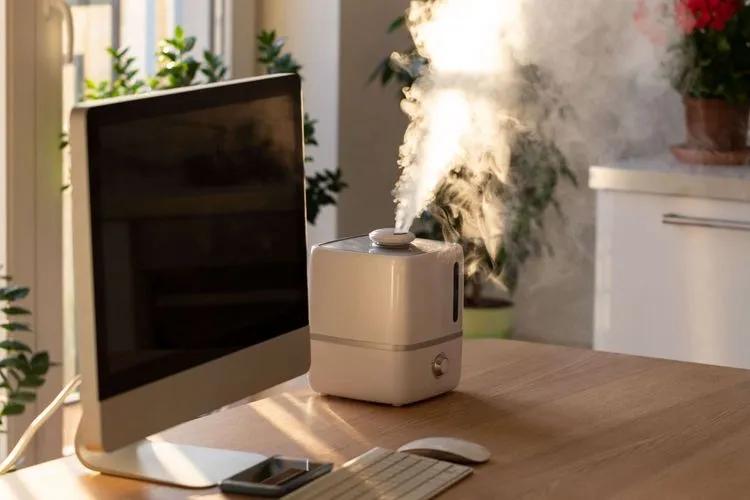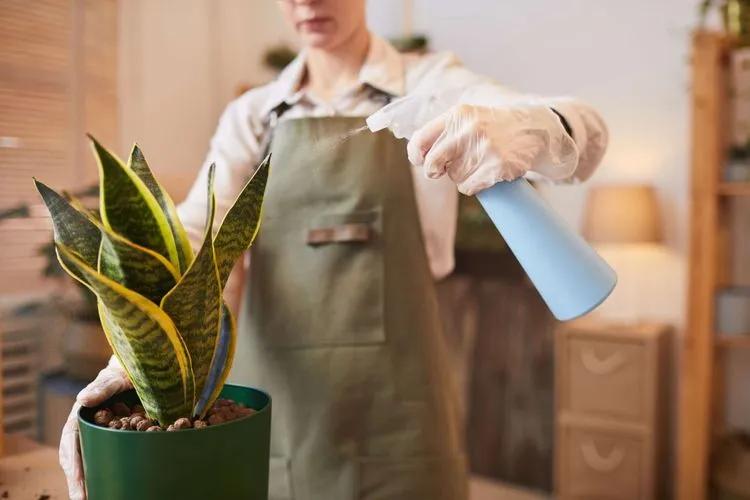High & Low Humidity Symptoms in Plants - How to Prevent It?
If you are a happy owner of houseplants, you should take care of their comfort as well. Maintaining the proper air humidity level is a huge necessity because many indoor plants originate from tropical places with humid climates. Thus, each houseplant has individual watering requirements, frequency, as well as intensity. Learn how to create a perfect microclimate for your green pets below.

Humidity Requirements
Many factors affect a plant's individual humidity needs:
- Species and size;
- The size of the planter;
- Season;
- Room temperature;
- Lighting;
- The composition of the soil or the quality of the potting mix.
Also, the weather plays a significant role in those needs as well. If the sky is cloudy and the room temperature is moderate, the plants need little moisture, but in the heat, many flowers need to "drink" regularly. Remember that the plant grows taller and wider over time, which means that even at a stable temperature and constant, optimal humidity, at some stage, it may need more water, which is called growth revitalization — a period of increasing demand for life-giving water.
You can determine that it is time to water by different methods — by touch or by weight. Thus, plants in ceramic pots require more watering than their counterparts in plastic containers. Crops with thin or drooping stems and large leaves or strong roots require more moisture than other species.
The Reasons for Low Humidity
Moisture support is usually needed after the winter period. During cold months, people turn on the radiators to increase the temperature. Thus, the humidity level immediately drops, and plants lose their strength. The tips of the leaves begin to darken and turn yellow, while the aerial roots quickly wilted. If you maintain high humidity for a long period, you may avoid the above problems but attract fungal disorders, white mold, rotting, or even pests. Yep, they all relish such conditions, which is why it's all about the middle ground.
Most plants thrive under 40-60% humidity level. Plants of tropical origin are more sensitive to such indicators; they better tolerate 80-90% humidity. In winter, when the heating is turned on, the indicators rapidly fall to 30-50%. To track the differences, you can use a hygrometer, which is often built into humidifiers and is very easy to use.

How Do You Know a Plant Is Thirsty?
Before watering indoor plants, make sure they need it. Many amateur flower growers act traditionally, checking the dryness of the earth by touch. However, this approach is correct if you "dig" with a stick deeper than the surface layer because the soil in the upper part can dry out, and below, it can retain high humidity.
Lack of moisture is indicated by:
- Drooping or fallen leaves;
- Sluggish shoots;
- Brown ends of the leaves;
- Mold;
- Rot;
- Falling off of young leaves;
- Slower growth.
The need for hydration can be determined by ear by tapping lightly on the surface of the container with your finger. When the soil is dry, a ringing sound will be heard; when wet, a dull sound. The weight of a pot with wet soil is significantly greater than that of dry soil. The methods, of course, are primitive. Still, with some experience and careful attention to domestic crops, they turn out to be very effective, especially when it comes to small flowers in standard pots.
Ways to Maintain Humidity
Spraying
A well-known method often used for flowers. It has a temporary effect and does not increase the humidity for a long time (gardeners usually use it for hygienic purposes). Also, not all plants will tolerate such a procedure, only those with very hard leaves: Ficuses, Monstera, and Succulents. Over-spraying can also lead to the origination of small pests. Each method has its own advantages, though: for example, if a spider mite appears on a flower, spraying can help a lot since the mite does not tolerate high humidity. Water for such a procedure should be boiled and then cooled slightly to room temperature. Thanks to this, the flower will not have a high-temperature drop, which will eliminate a lot of stress, and you can also avoid the appearance of salt stains on the leaves.
Pallet with Drainage
Pebble trays cause water evaporation, increasing the room's humidity. The pot with the plant itself must be in a different container since moisture must not be allowed to enter through the drainage holes. Also, it will be a plus if the tray has a special mesh and a deep bottom so that it is more convenient to add water, clean the container and place the plant directly on this mesh. Well-known expanded clay is well-suited for drainage. In fact, this option helps to grow even very capricious plants.
Vessels with Water
Suppose the green inhabitant is placed on the windowsill under which the battery is located. In that case, you just need to put quite wide containers with water so that the evaporation area is as high as possible. Add water periodically.
Household Humidifiers
The easiest way to increase humidity is to buy a humidifier. We recommend using Honeywell, TaoTronics Cool, Vicks Warm, or Pure Guardian. The area of influence of a humidifier is huge, so it will be useful both for the beloved plants and their owners.

Types of Humidifiers
There are generally two types of humidifiers available on the market:
- Steam. It makes the water heat up and come out with steam. The average water consumption per day is about 16-17 liters. They can work even with very hard water; some come with inhalation nozzles. You can help not only your green friends but also your household.
- Ultrasonic. This type of device has a special membrane that turns water into cold steam thanks to frequent vibrations. It has a low noise level (unlike the previous one); moreover, you can adjust the humidity level independently. A tiny drawback, though — a white coating may form on the furniture. Don’t worry — you can easily wipe it.
Other Options
Not only humidifiers are helpful while dealing with low humidity levels for plants. There are several convenient options:
- Aquarium. Anyone with an aquarium at home can start to rejoice, as this really works for plants too. It will be enough just to put the green pet next to it; the evaporated moisture will do its work.
- Terrariums. There is already a flight of imagination of all gardeners. This design creates the most favorable conditions for growing flowers. Although, creating a terrarium might be a time-consuming process. There are many influencing factors and special techniques on how not to harm the plant and do everything with benefit.
- Home fountains. Whoever has small fountains in the interior will not face problems with humidity. They are not only aesthetically pleasing and calming but also help your favorite flowers to thrive.

Devices for Determining Soil Moisture
Most of the problems for amateur flower growers are created by representatives of the flora planted in large, voluminous pots or barrels whose height exceeds 30 cm. As practice shows, they most often suffer from waterlogging. To protect such plants, you can purchase one fairly simple device that allows you to determine the soil moisture level.
Before watering the specimens in tubs, following the instructions, you will use the indicator, the arrow on the scale, which will show if the soil is dry or still wet. Cheap devices wear out quickly enough, and at some stage, they begin to show very dubious readings. Based on this, ideally, it is worth changing the measuring device annually.
Even a new apparatus will be wrong if mineral salts have accumulated in excess in the soil. This happens if plants are watered with too hard water for years. This is the case when incorrect indicator data is a signal that the flower's land needs to be urgently changed.
Modern sound moisture meters are also convenient. As soon as the plant begins to feel thirst, the device informs about it with a ringing or, for example, a lingering whistle. It is advisable to install such a device in a flower pot that requires moisture earlier than others. Before watering the plants, it is worth checking them with any of the above methods.
Do I Need to Follow the Watering Regime?
Ideally, watering indoor plants must be carried out strictly according to the regime. Information on the rules for moistening the soil can be obtained from encyclopedic descriptions of the cultivation of a particular flower. In general, there are three types of watering:
- Rare moisture. Cacti, Gloxinia, Succulents, and many other plants do not need hydration for several weeks.
- Abundant watering. It involves moistening the soil immediately after the soil clod dries out and is needed by the vast majority of tropical crops with thin leaves, such as Azalea, Begonia, Ficus, and other similar plants.
- Moderate watering. It's especially suitable for species with pubescent stems and leaves, such as Peperomia or African Violet. House flowers with thick roots (Asparagus, Dracaena, columnea, Palm, Chlorophytum, and others) also love this kind of moisture. It involves adding water one to two days after the earth dries out.

Final Thoughts
Of course, when there are a lot of plants, you may be confused by their different watering needs. We recommend dividing all flowers into three types depending on the need for moisture and periodically checking the soil of each indoor plant for dryness.
Remember that it is much more beneficial to moisten plants' soil more often and little by little than to arrange abundant watering from time to time. When active growth occurs in spring and summer, flowers should be watered more often and abundantly than in autumn, when the plants are dormant.
You can also learn the practice of cultivating plants in a hydroponic system. In this case, you can pay close attention to them a couple of times a month; the rest of the time, the soil will be moistened automatically. If necessary, buy granulates, hydrogels, and other compounds that retain moisture.
FAQ
What Are the Signs That a Plant Is Experiencing Low Humidity?
If your plant is struggling with low humidity, you’ll often see dry or crispy leaf edges, curling or drooping leaves, and slower growth. Brown spots or leaf drop can appear too, especially on tropical plants.
